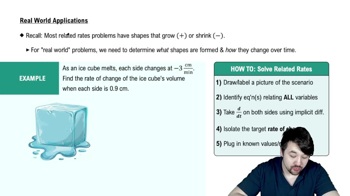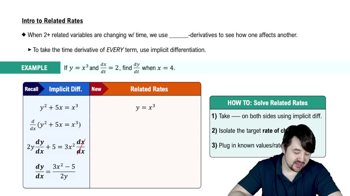Table of contents
- 0. Functions7h 52m
- Introduction to Functions16m
- Piecewise Functions10m
- Properties of Functions9m
- Common Functions1h 8m
- Transformations5m
- Combining Functions27m
- Exponent rules32m
- Exponential Functions28m
- Logarithmic Functions24m
- Properties of Logarithms34m
- Exponential & Logarithmic Equations35m
- Introduction to Trigonometric Functions38m
- Graphs of Trigonometric Functions44m
- Trigonometric Identities47m
- Inverse Trigonometric Functions48m
- 1. Limits and Continuity2h 2m
- 2. Intro to Derivatives1h 33m
- 3. Techniques of Differentiation3h 18m
- 4. Applications of Derivatives2h 38m
- 5. Graphical Applications of Derivatives6h 2m
- 6. Derivatives of Inverse, Exponential, & Logarithmic Functions2h 37m
- 7. Antiderivatives & Indefinite Integrals1h 26m
- 8. Definite Integrals3h 25m
4. Applications of Derivatives
Related Rates
Problem 30c
Textbook Question
Consider the following cost functions.
c. Interpret the values obtained in part (b).
C(x) = 500+0.02x, 0≤x≤2000, a=1000
 Verified step by step guidance
Verified step by step guidance1
Identify the cost function C(x) = 500 + 0.02x, where C(x) represents the total cost for producing x units.
Determine the fixed cost by evaluating C(0), which gives the cost when no units are produced.
Calculate the variable cost per unit by analyzing the coefficient of x in the cost function, which is 0.02.
Evaluate C(1000) to find the total cost when producing 1000 units, which will help in understanding the cost structure.
Interpret the results by discussing how the fixed cost and variable cost contribute to the total cost at the production level of 1000 units.
Recommended similar problem, with video answer:
 Verified Solution
Verified SolutionThis video solution was recommended by our tutors as helpful for the problem above
Video duration:
3mPlay a video:
Was this helpful?
Related Videos
Related Practice






